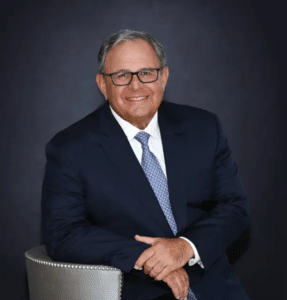This article originally appeared in the June 2025 edition of MortgagePoint magazine, online now.

Welcome back to “Sidebar With Stan,” MortgagePoint’s quarterly feature, where we ask Freedom Mortgage CEO Stanley C. Middleman topical questions about a subject of interest.
Middleman serves as the President and CEO of Freedom Mortgage Corporation, one of the largest and fastest-growing independent mortgage companies in the country. He is a nationally recognized business strategist, investor, and philanthropist, with over 35 years of experience in the mortgage banking industry. Since founding Freedom Mortgage in 1990, Middleman has grown the company into one of the nation’s largest nonbank mortgage lenders/servicers, as well as a top VA and FHA (government-insured) lender. Middleman is an active member of the MBA, where he serves on the MBA Board of Directors and previously on the MBA Residential Board of Governors. He has also served on numerous advisory boards within the mortgage industry, including the boards of Freddie Mac, Fannie Mae, and Ellie Mae. He is currently a member of the Housing Policy Executive Council.
This quarter, we’re asking Mr. Middleman about homeownership: how the industry can support it, what its responsibilities are regarding ensuring it is offered responsibly, and potential homeowners are educated properly, and what lessons he has learned about it from his three-decade career.
Q: What role do you see FHA and VA loans play in expanding homeownership when it comes to first-time homebuyers or veterans? Is that shifting, due to all the changes in Washington, D.C., this year?
Middleman: Right now, it’s mostly the same. As much as things have changed, much in the homeownership industry has stayed the same. Both FHA and VA loans serve a very important role in helping people own their homes, as they’re able to borrow at very high percentages of the purchase price. At the end of the day, the liberal credit criteria lend themselves to a person of lesser means: They can get into that first home. It’s also great for someone who has an expanding household and needs more room for their family in a world that is increasingly more about living, working, and playing all in the same spot.
Homeownership is more important than ever before, and the same great tools that we’ve been using for the last 50 years are still at our fingertips.
Q: Are there ways that the mortgage industry can or should try to help more Americans on the path to homeownership, especially low- to moderate-income aspiring homeowners?
Middleman: If we learned anything from the Great Financial Crisis and the Great Recession, it’s that expanding homeownership beyond those who can get there with the tools that exist today is dangerous and probably inappropriate. We have seen that homeownership at a 60% to 65% rate of the population is a good number. It probably shouldn’t be much lower than that, and it probably shouldn’t be much higher than that.
During the Great Recession, we approached 70%, which, if your only interest was having more homeowners, would have been great. The problem was that it resulted in more foreclosures than at any time in our history since the Great Depression. I think it’s a bad idea to widen the credit box, and it becomes an even scarier proposition when you’re at the highest valuation in homes since the Great Recession. Being a good, responsible lender includes not only helping those people who qualify for a home but also helping people who don’t qualify understand what they need to do to qualify in the future. We help identify the best home loan for each borrower, and if they don’t qualify, we provide guidance, such as advising them to save more, which can lead to having a bigger down payment and lower monthly payments. Most importantly, we counsel them to buy a home that they can afford, not a home that they see as a piggy bank or an investment.
Housing is more than homeownership, and homeownership is more than housing. Where you live is important, whether you’re a renter or an owner, and having the ability to aspire to live in a good community and grow into homeownership is very valuable. It helps build strong neighborhoods. Strong neighborhoods are one of our nation’s greatest strengths, and the fact that there are so many homeowners—relative to those who rent—is evidence of that.
Q: Are nonbank lenders like Freedom Mortgage positioned to support borrowers in ways that traditional banks aren’t?
Middleman: It’s hard to get a government loan from a traditional bank. We are the leading Ginnie Mae issuer, the top FHA lender, the top VA lender, and one of the top USDA lenders. Those loans help underserved, active-duty military personnel, as well as people who live in rural areas. At Freedom Mortgage, we have the expertise and knowledge of these government-backed loans, so we can find the best loan for our borrowers. Traditional banks don’t offer as many options when it comes to home loans. There was a time when they dominated those markets, and that time is not now. Freedom Mortgage is committed to helping customers. At the same time, we’re also focused on conforming loans and the good borrowers with a decent down payment who get conventional loans. They’re the meat and potatoes of our industry, representing probably 60% or 70% of the total industry’s production.
The thing that nonbanks are probably less good at is jumbo loans that are made for the highest earners. Those tend to come from a bank, where they do wealth management and provide other credit facilities. When you think about the breakdown of who the customer is, banks want to provide customers with multiple products, whereas we’re in the business of homeownership: financing residential loans and supporting the first-time homebuyers, underserved communities, active-duty military, rural homeowners, and the regular person with a regular job who gets a conforming loan that’s neither stressed nor needy. Those groups of people are who we focus on.
Q: Do you think we’re in danger of seeing any sort of correction or downturn within the housing market?
Middleman: It’s always good to have equity, but it’s better to live in a house you can afford. If you live in a house that you can afford, don’t leverage it up so much that you can no longer afford it. I think the best mortgage is no mortgage, and the best way to get rid of your mortgage is to pay it off and live within your means. Make sure you’re making your payment every month, and, over time, you’ll build a nest egg to retire with.
Your kids will have the home that they had their memories in. And if you want to move up and can afford a nicer home because you built up a lot of equity, and you have a different family dynamic than you had when you started, you can use that equity to purchase a larger home. Just make sure that your family is living in a house that fits your needs and your budget.
Q: You mentioned some of the government loans that Freedom Mortgage handles, and you’ve previously served on the boards for some of the GSEs. Did you take any lessons from those experiences that gave you a better understanding of how the industry can best work with the government and the GSEs?
Middleman: I don’t know if I want to shape society, but I will tell you that the GSEs were meant to drive the percentage of homeownership under the premise that homeownership was good. I think they may have taken several strides too far, particularly when I served on those advisory boards. Their missions were overzealously pursued during the Great Recession, and if they had stuck to their knitting and allowed FHA and VA to focus on first-time homebuyers and high-LTV borrowers, a lot of the problems that we’ve faced wouldn’t have occurred. It was the opening of that credit box, in particular by the GSEs and the private-labeled securities that levered them, that opened the gateways to the problems that occurred.
It became very challenging because people overshot their responsibility to the marketplace. The solution is to stick to your knitting.
Q: Are you seeing any changes in the demographics of homebuyers?
Middleman: We’ve seen a cultural expansion in the demographics, and we’ve seen an aging population. That should add supply over time, because there’s a lot to be understood about immigration, about how many first-time homebuyers we’re going to have. Where is that next level going to come from? I think that the demographics, as we see them here in the United States, are going to be somewhat stable.
We know a big chunk of the population is getting older. We know the baby boomers are going to retire, and what happens next is going to be a question. Are they going to age at home, or will they need different facilities? There are a lot of questions about the change in that population, but, for the foreseeable future, I don’t think demographic changes are going to play a large role in shaping housing, at least through the 2020s. What happens in the 2030s and the 2040s remains to be seen, because there’s a lot of policy change that could impact that, particularly around immigration.
Q: From your three decades in the industry, is there one lesson about homeownership that you’ve learned that has remained true?
Middleman: When it comes to credit, the percentage of skin in the game that you have matters. We have found that it’s the driver, even though your debt-to-income ratio (or how much you can afford to borrow), has an impact. Your history of making payments has an impact. At the end of the day, people with a lot of value in their homes end up not getting foreclosed on.
As a lender, the loan-to-value ratio (LTV) matters. How much you owe against the value of your home, and what that ratio is, is a big deal. The reason we get in trouble when we open the credit box is that we raise the percentage of the population that has a higher LTV and therefore, has less skin in the game. That puts more people at risk and subject to the value of their homes going down. If you already don’t have much money, and you’re upside down in your home, it’s frustrating and emotionally difficult to make that payment, knowing you’re not going to be able to break even.








